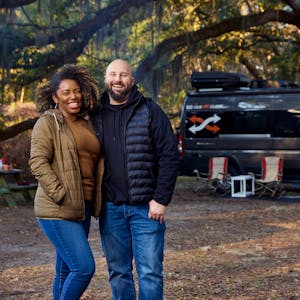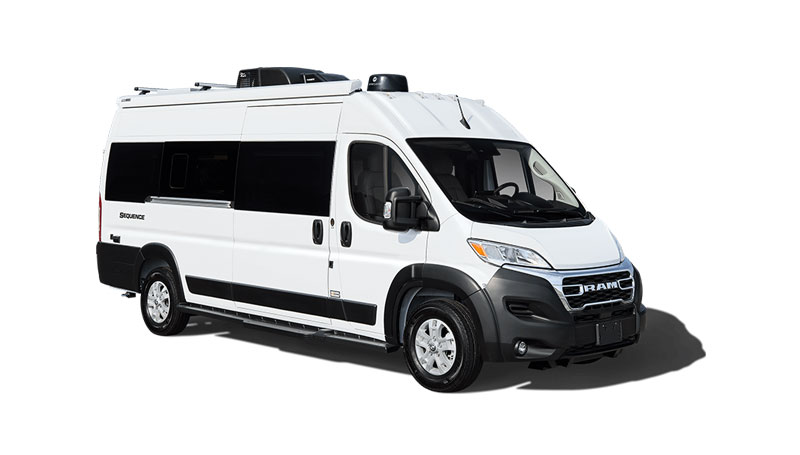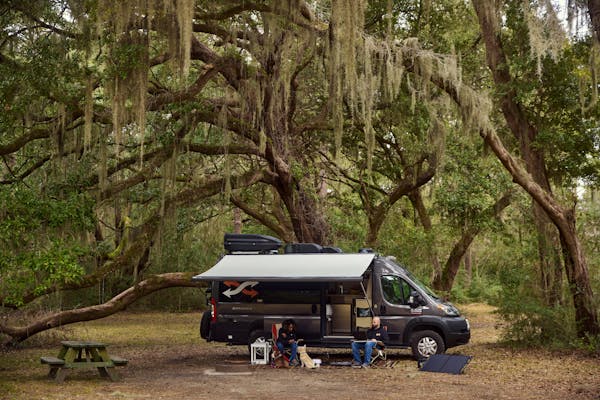Before You Boondock
Start by having a rough idea of where you want to stay and what you want to see. Are you thinking of totally remote mountains, somewhere near a national park or a spot close to water? When we plan our boondocking trips, we like to find a general location and then see what’s nearby. Once we have an idea of where we want to be and what we want to see, we begin to create a route for the drive. Depending on what RV you have, there are several RV-specific GPS apps that can help you determine the best route based on the length, height and width of your RV. CoPilot, RV Trip Wizard and inRoute are three great RV-specific options, as well as Google Maps. Comparing multiple routes gives you a few different driving options, and helps you avoid things like low bridges, tunnels and roads with weight limits. Google Maps is also great for scouting the boondocking location and nearby roads because you can use both satellite view and street view. Additionally, you can download maps within the Google Map app and still access them when you don’t have service. You should always take pictures or screenshots of the driving route to and from your boondocking spot. This way you’ll have them as a back-up in case you find yourself without any cell service.
Narrowing In On Your Boondocking Spot
After you’ve figured out your general location and preferred driving route, then you can really dig into finding a specific place to boondock. It won’t help if you find the perfect boondocking spot, only to realize your RV can’t actually get to it. For much more remote boondocking places, we prefer to use websites like Campendium, Free Campsites and Bureau of Land Management. Apps like Sēkr and iOverlander are also great options. If you’re looking to do some city-based boondocking or boondocking in unique and unusual places, Boondockers Welcome and Harvest Hosts offer privately-owned boondocking locations with reservations. These spots can vary from driveways and backyards to vineyards and cattle farms. And while not all of these websites and apps will include detailed breakdowns, comparing several different resources can help you narrow your search, and even provide reviews, pictures and cell service strength.

Prepping For Your Trip
Since you won’t have any hook-ups, preparing for a boondocking trip will take a little more planning than a standard campground visit. First, make sure you have all the essentials, including enough food and water to last the length of your stay, as well as medical supplies and a roadside emergency kit. Be sure and let someone know what your itinerary is before you leave. Cell service can be spotty when boondocking, so it’s good to keep a friend or family member informed of when you plan to return. If you plan to boondock with a large group, walkie talkies are a great way to stay in-touch. Before you head out, take a look at topography maps and the weather for your destination so you can have an idea of the terrain and forecast—both of these may impact what you bring with you (leveling blocks, extra water, warmer clothes, etc.). Finally, make sure to empty your gray and blackwater tanks, refill your freshwater tank and do a quick maintenance check to ensure your RV is in proper working order.
Managing Your Resources
Make a list of everything you will need on your boondocking trip. Then, check to see if there are places near your destination where you can pick up some of these items. We try to pack all of our food and grocery items before we leave for our trip. Even if there is a grocery or convenience store nearby, road conditions and weather can impact how easy it is to drive there and back. Gas and propane are two other important resources, so try and find the closest gas station to your destination and fill up before you arrive. And lastly, since Rocio and I work full-time on the road, we know we’ll need internet or decent cell service. Although we have a WiFi booster in our camper van, we make it a priority to try and find boondocking locations with some cell service. If we arrive somewhere and there is no service, we may have to cut our trip short. Luckily, some of the boondocking websites we shared will tell you how strong the cell service is so you can plan accordingly. Here’s a quick check-list to run through before you head out:
- Empty gray and blackwater tanks
- Fill freshwater tank
- Fill up on gas and propane
- Pack groceries and extra drinking water
- Fully charge all battery-powered items

Setting Up Camp
Everyone will have their own unpacking routine. Style of travel, how frequently you move around, climate, terrain, and preferred activities will all dictate what you bring and the amount of time it will take to set up camp. Since Rocio and I like to move quickly and often, we prefer a more minimalistic campsite. We’ve broken down our setup into the following steps:
1. Exterior Set-Up
- Unfolding camping chairs
- Setting up a small outdoor table
- Pulling out the RV awning
- Setting out solar panels
- Leashing our dogs to a nearby tree or secure fixture
2. Power
- Turning on the propane tanks to power our hot water, stove and refrigerator
- Checking our batteries to make sure they’re fully charged (if needed, our solar panels can help charge the batteries)
3. Interior Set-Up
- Unhook or unbundle any items that were secured while driving
- Set up bed and/or workstation
- If it’s warm outside, open doors and windows to provide a breeze
- If it’s cold outside, turn on the heater and hot water to warm things up
Since we’re in a Class B camper van and use this RV as our primary vehicle, we also like to set up a small tent at our boondocking site. This not only acts as an additional storage space but also as a site marker to save our spot should we need to leave for the day. Just make sure you don’t leave anything valuable or edible (there might be wild animals around) inside the tent.

Frequently Asked Boondocking Questions
1. What is the best RV for boondocking?
While there is no single, best RV for boondocking, there are some specific features that make boondocking easier and better. Overall size and length, tank capacity and solar power packages are three important things to look for if you plan to boondock with your RV. For us, our Class B camper van is perfect for a few reasons. Not only does it offer all of the comforts and luxuries we could possibly need—including a bathroom—everything comes equipped in an easy-to-drive, nimble van. The smaller size allows us to camp almost anywhere and fit in tighter, hard-to-maneuver spaces. We also have a generator and solar onboard, as well as a full kitchen, a microwave and air conditioning. Having air conditioning is really important, especially if you plan to boondock in warm climates. And if you work from the road like us, you can always buy a supplemental internet package that will help you stay connected, even in remote places.
2. Why should I boondock over staying at a campground?
Campgrounds are great, especially if you are new to RVing and want to ease into the lifestyle. And while Rocio and I frequently stay at campgrounds, we prefer to boondock for a few reasons. First, we absolutely love the feeling of being fully immersed in nature. Some of the most beautiful places we’ve visited have been in the middle of nowhere, where we can simply open our doors and step right out into the wilderness. Second, the wide open spaces are great for our two dogs. While you still have to be mindful of other boondockers and local wildlife, boondocking allows our dogs to roam free and not have to worry about the confines of a traditional campsite. Third, during the peak summer season, campgrounds can get crowded and cost upwards of $100 per night depending on the location. But with boondocking, you typically don’t have to pay to camp and you rarely have any neighbors nearby. Plus, the lack of check-in and check-out times while you boondock is a nice bonus.
3. Where are some of the best boondocking spots?
Where you choose to boondock is highly dependent on personal preference and overall comfort level. Rocio and I have been lucky to boondock all over the country, and we have a few recommendations. If you’re looking for a spot without hook-ups, but still want some people around for security, then state parks and national forests are ideal for boondocking newbies. Unless otherwise posted, almost all national forests and national grasslands are open for recreational use, including boondocking. For completely off-grid locations, much of the land outside national parks is perfect for much more remote camping. Utah has countless public land just outside of its five national parks. And the same goes for Grand Teton National Park in Wyoming. One of our absolute favorite boondocking spots is about six miles up the road from the main entrance to Grand Teton, just past Heart Six Ranch. Another one of our favorite boondocking spots is Upper Piney Lake just outside of Vail, Colorado.

Going on a boondocking trip might require some extra preparation and planning, but as long as you research your location thoroughly, pack plenty of essentials, and practice safe, considerate camping, we know you’ll come to love the adventure as much as we do.











